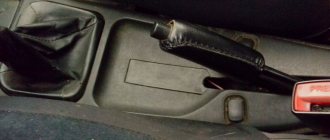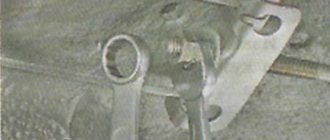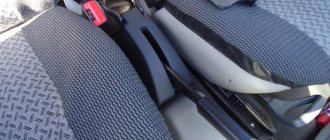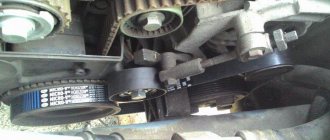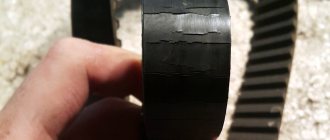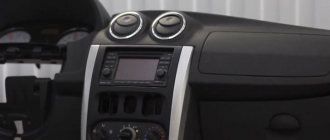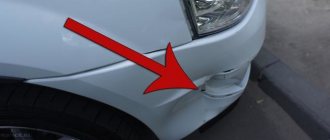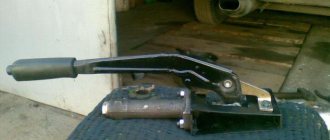- Why is the brake light on?
- Possible reasons why the handbrake light is on: opinions of car owners
- How is the replacement performed?
- When to tighten and when to change?
- When to tighten the nut
- Components
- The principle of adjusting the handbrake
- Causes of malfunction and their elimination
- Checking the mechanical component
- Recommendations for the braking system
- Handbrake repair for Lada Vesta
Why is the brake light on?
But let's start with the design features of the brake system alarm. Previously, cars used only one sensor - the level of brake fluid in the system, which sent a signal to the warning lamp. Since fluid is the main working element of the system, and its leakage leads to the brakes stopping working, naturally, the designers installed a sensor to monitor the level.
Additionally, the car also has a parking brake, the use of which must be monitored by the driver. On some models, the warning lamps for the working and parking systems are separated. The warning light with an exclamation mark in a circle is responsible for the fluid level, and the indicator marked with the letter “P” signals that the handbrake is engaged, and it turns off after the car is released from the handbrake.
But often a car has only one warning light, to which both the liquid level sensor and the handbrake sensor are “attached”.
Modern cars use circuits that additionally include brake pad wear sensors and brake light lamps. Failure of these elements causes the lamp on the dashboard to light up.
There are other design nuances that cause the indicator to glow. On VAZ models of the 10th family of the first years of production, a starter protection relay was included in the circuit, which forcibly turned it off after starting the engine. In this circuit, the designers connected the power supply circuit for the brake system lamp to this relay.
Why does the brake warning light on the dashboard come on or does not go out after starting the engine? If this happens while moving, it is better to stop moving and carry out diagnostics. If the light does not go out after starting the engine, it is better not to drive until the problem is resolved.
Parking brake device
Before replacing the handbrake cable or tightening it, you need to understand the design of the mechanism. It is designed quite simply and consists of the following main parts:
The parking brake works like this: when the driver lifts the lever in the passenger compartment, the rocker moves forward and acts on the pads through a cable drive. In drum mechanisms, the brake pads move apart, and in disc mechanisms, they converge. The “handbrake” holds only the rear wheels and functions independently of the main brake system, which is activated when the pedal is pressed.
The handle is fixed in several positions thanks to the latch. To unlock it and lower it to its original position, a special button is installed at the end of the handle. If the pads “grab” the wheels on the second click, and after the fourth click they hold the car securely, then the drive is considered to be working well.
Possible reasons why the handbrake light is on: opinions of car owners
- Changed the hubs. “The light in my car blinked sometimes. At first I decided that the problem was with the pads. But later I remembered - I replaced the pads not so long ago. I checked the brake, everything is fine. And then I thought about why the problem could arise? I didn’t think of anything and stopped worrying. The indicator continued to flash periodically... As a result, the right hub bearing began to make noise, after a while it began to hum so loudly that the sound simply made my head split. I first purchased one hub. Then I thought that it would be better to change both parts at once - or rather, this should be done. I bought a second one, changed it, and the problems all disappeared: no noise, no blinking light.”
- Got a good technician! “The handbrake light would come on from time to time while driving. Quite often this happened after bouncing on the pit. I went and bought a brake fluid. And I found a specialist right at the dealership. He then flooded it. He also climbed under the handbrake and said that perhaps the microphone at the lever was acting up (it seems like this happens sometimes). Take the train and watch. But the problem disappeared after filling the brake fluid. The handbrake no longer lights up. By the way, I met an excellent specialist and looked for the problem for free, with pleasure and without showing off.”
- Depending on the situation, “If the light starts to light up after shocks, for example, on a hole or bump, then, most likely, the brake fluid level is on the verge of the required level or lower. You just need to add it and that's it. If it lights up when braking, the pads are definitely worn out completely. I went through this myself in my VAZ.
How is the replacement performed?
When replacing Renault Logan parking brake cables, our video will show you what to do when doing the repair yourself. It is worth noting that the right and left rear cables are changed in the same way.
To restore the handbrake of Renault Sandero, LADA Largus, the installed cable is removed and replaced as follows:
- The tension of the drive cables is loosened by unscrewing the adjusting drive nut on the handbrake.
- The brake drum is removed.
- The rear brake pad is removed, and the cable tip is disconnected from the lever, which removes the pad itself.
- The cable sheath clamp is compressed.
- The cable is removed from the hole.
- The cable is removed from the holder located on the beam lever.
- It is necessary to pull it a little into the cabin, and then remove it from the equalizer.
- We completely remove it from the hole in the body.
When replacing the handbrake cable on a Logan, you may encounter a situation where it cannot move freely in the sheath. Therefore, it must be lubricated with transmission or engine oil (at your own discretion).
Even before replacing the handbrake cable, it is important to make sure that the new cable is long enough to be installed on the vehicle. Otherwise you will have to buy a new consumable.
As is clear from the instructions, the procedure is quite simple. The parking brake will be repaired only if all operations for independently replacing the cable and checking its operation by placing the car on an incline on the handbrake are followed. The new part is guaranteed to last for several years without any problems.
Adjusting the hand brake on the Lada Granta ⋆ I Love My Lada
It would seem like a trivial matter to tighten the handbrake. But not the Lada Granta. This frantically budget car managed to surprise many owners this time too. Due to the design features and saving on small things, before pulling up the tame ones on the Grant, you need to have a good dance, and without a pit it will be difficult to do anything. Whether you like it or not, you need to tighten it up.
Hand brake device Lada Granta
Theoretically, the Lada Granta should have replaced the outdated VAZ 2107 a long time ago, but for various reasons its release was delayed. The car was conceived as the cheapest in the VAZ model range and this idea was fully realized. The Granta's brake system differs little from the brakes of classic Lada cars, even in layout - the same disc brakes at the front with a floating caliper, the same drum brakes at the rear.
The design of the Lada Granta brake mechanism does not even provide for the simplest system of automatic adjustment of the gap between the block and the drum
The handbrake drive is also the simplest, but the brake mechanism itself does not even provide a primitive system for automatically adjusting the gaps between the block and the drum. The force from the handbrake lever is transmitted directly through a cable with an equalizer to lever 9 in the brake mechanism. Consequently, after wear of the friction lining 8, even by 2-3 mm, the handbrake cable has to be tightened. The design of the brake mechanism with a handbrake drive Again, theoretically, a threaded rod with an adjusting nut (in the photo below, item 6) could easily be placed in the cabin, but this would require the use of additional parts or changes to ready-made factory dies. Therefore, VAZ engineers decided not to worry and leave the design as is. To adjust the cable tension, the driver must approach the adjusting nut from below, which is not always convenient, especially in cold or wet weather. In addition, the threaded rod is constantly surrounded by dust and moisture, so it rusts, and it is not so easy to get to it from below.
How to tighten the handbrake on a Lada Granta, when to tighten it
Tightening the handbrake cable is necessary in cases where the parking brake lever does not release the brake pads in the upper position. According to science, the pads should block the wheels at 4-6 clicks and hold the car on a slope of 20-25 degrees . Otherwise, we won’t even be able to pass the technical inspection.
Parking brake design
To tighten the handbrake cable, we need to unscrew and move to the side the protective cover of the muffler resonator. It is attached to four studs welded into the body. The difficulty is that when unscrewing these four nuts with a 10mm socket, there is a danger that the studs will break, since the threads often sour and rust.
Broken heat shield mounting studs
In this case, adjusting the handbrake may result in drilling the bottom and welding new 6 mm bolts up to 25 mm long. As a last resort, they can simply be inserted into the hole in the bottom by inserting a powerful washer and placing a grommet under the head of the bolt. In a word, we have already prepared ourselves mentally, all that remains is to consider the process itself.
And yet, it is very important to treat these same casing studs in advance with a penetrating lubricant, for example, WD-40. True, this is also connected with traveling under a car.
We adjust the handbrake on Grant with our own hands, video
If we are ready for difficulties, then for adjustment we will need a standard set of tools, grease for processing threads and lubricating the compensator, as well as an inspection hole or overpass. If everything is ready, let's go.
- Release the handbrake completely and go under the car.
- We find the studs with nuts we need and try to unscrew them with a 10mm socket.
- Remove the rubber muffler hanger from the bracket and move the heat shield as far forward as possible.
- We gained access to a 13 mm nut for adjusting the tension of the handbrake cable.
- Use an open-end wrench to hold the locknut, and with another wrench we tighten it several turns, controlling the tension of the cable.
- We tighten the cables until they are lightly tensioned, and then check the tightening force. The suspended rear wheel should rotate freely when the handbrake lever is lowered.
After this, we check the parking brake in accordance with the regulatory data. Below we have attached a video of the process of extreme adjustment of the handbrake on Grant. Good luck to everyone and strong brakes!
Post Views: 1,133
When to tighten and when to change?
During operation of the machine, the steel cable gradually stretches and begins to sag. Then part of the lever stroke is used to remove this slack (the first 2-3 clicks), and only then the force is transferred to the brake pads of the rear wheels. As a result, they are weakly pressed against the surface of the discs or drums and the car does not brake reliably.
The first sign of a malfunction is that the handbrake stops working on the first two clicks of the handle and is raised by hand without any effort. In this case, it is definitely necessary to tighten the hand brake, or rather the cable drive.
But the operation of the mechanism also depends on other factors:
- on the degree of wear of the brake pads;
- from the depth of excavation on the surface of the steel disk or drum.
Abrasion of the linings does not have much effect on the operation of the main system, since the stroke of the hydraulic pistons is quite large. But the effect of the mechanical “handbrake” gradually weakens. To return it to working condition, it is necessary to compensate for the wear of the elements by tensioning the drive.
The cable is replaced in the following situations:
- The element has stretched to such an extent that at maximum tension the pads do not grip the discs and the car rolls away on any slope.
- Due to the constant ingress of water under the cable casing, it rusted and became tightly jammed. This happens when a motorist rarely uses the handbrake.
Cable jamming also occurs in winter, when water trapped under the casing freezes inside. In this situation, do not rush to change it; first warm up the car in the garage, and then drive out the moisture using WD-40 aerosol lubricant.
The principle of operation of the handbrake on Grant
Why does it need to be tightened frequently?
This is the peculiarity of the mechanism, which is why you often have to tighten the handbrake. Plus low-quality spare parts from the beginning, and a design that has not changed since the time of Tsar Pea!
In foreign cars (not all of course), the rear brake mechanism (drum or disc) has self-tensioning springs, which are tightened depending on the wear of the pads.
How a properly configured handbrake should work
The handbrake movement in a Lada Granta car should be no more than 6 clicks from the moment it is raised. It is possible to increase the handbrake stroke to 8 clicks, but it is not recommended.
It shouldn’t be like this (the brakes don’t grab the rear wheels)
Ideally, of course, 3-4 clicks. With this setting of the handbrake, you will have a reserve of movement when the cable weakens and the wheels begin to grip later.
If you experience a situation where the handbrake is “pulled out” to its fullest extent, but the wheels do not grab, then the following reasons are possible:
When to tighten the nut
If this does not help you, you will have to use the adjusting nut to adjust the brakes. To do this you need to do the following.
- Open the plastic plug under the handle. It can be easily removed.
- Remove another plug, under which there is an adjusting nut.
- Take a long 10mm socket and tighten the nut.
This completes the adjustment of the hand brake on the Lada Vesta. But I didn’t do this on my car (or rather, not mine, but my wife’s), because I think that automatic adjustment was enough. Therefore, I also advise you to use the automatic function first. If this is not enough, then tighten the nut.
On the Lada Vesta, to adjust the handbrake you no longer need to crawl under the car, as before on the “nines” and “fours”. I hope that the review was useful for someone, and someone probably already knew this trick. Thank you for reading, good luck on the roads everyone!
Step-by-step instructions for adjusting the parking brake drive
It is convenient to carry out adjustments on an inspection hole or overpass. It's better to do it with an assistant. You will need the following tools: two open-end wrenches for 13, a wrench, an extension, sockets for 10 and 13, WD-40.
In motorsports, the handbrake helps put the car into a controlled drift. This requires certain skills and abilities.
Remove the muffler from the rubber pads and move it to the side
To get to the handbrake adjustment mechanism, you must first remove the muffler from the rubber cushions and move it to the side. There is protection above the middle part of the resonator. It needs to be removed. The protection is secured with 4 bolts, unscrew them using a wrench and a 10mm socket.
Unscrew the protective screen over the central part of the resonator. It is secured with 4 bolts with a 10mm head.
Pull up the parking brake
Using a 13mm wrench, unscrew the locknut on the handbrake rod
Loosen the handbrake drive
If the wheels rotate with difficulty when the handbrake is lowered, then the parking brake must be loosened.
Components
In such a situation, there are 2 scenarios:
- Carry out modifications in accordance with the factory diagram;
- Purchase components from another manufacturer.
And so, one of the owners of the Lada Vesta in the Exclusive configuration said that he was able to find out from an AvtoVAZ employee exactly what components were needed to replace drum brakes with disc brakes.
According to an employee of the plant, there is no need to replace the beam or reflash the ABS block, and this significantly speeds up and reduces the cost of the work.
In addition, the picture clearly shows that there is a standard spacer between the axle and the beam and it is to this spacer that the boot is fixed. From the factory, the hub and disc come separately, so after installing the rear disc brakes on the Lada Vesta yourself, there is no need to replace the bearings if you need to replace the disc.
All the components necessary to replace the brakes with your own hands are presented in the table along with the article numbers.
| Position | vendor code |
| Right brake hose mounting bracket | 8450031136 |
| Left brake hose mounting bracket | 8450031137 |
| Rear brake flexible hose assembly – 2 pcs. | 8450031129 |
| Rear brake pads (full set) | 11196-3502089-00 |
| Washer 10 | 00001-000516870 |
| Ball joint fixing bolt | 21080-2904194-00 |
| Washer 10 | 00001-000516870 |
| Ball joint fixing bolt | 21080-2904194-00 |
| Rear left brake (assembly) | 8450031163 |
| Rear right brake (assembly) | 8450031162 |
| Retainer fixing screw | 21080610526810 |
| Rear brake disc | 8450031131 |
| Rear wheel hub (assembly) | 8450031130 |
| Hex Head Screw | 00001-003836021 |
| Right rear brake guard | 8450031686 |
| Left rear brake guard | 8450031687 |
| Bolt M10-1.25-40 | 8450031161 |
| Left rear brake mount | 8450031132 |
| Right rear brake mount | 8450031133 |
The estimated cost of the entire kit for self-installation of rear disc brakes on a Lada Vesta is about 30,000 rubles.
The principle of adjusting the handbrake
- Fully lower the handbrake lever in the cabin.
Lower the handbrake handle
- Place the car on a pit or lift it on a lift. Some car owners manage to adjust the handbrake “from the curb” - but this is inconvenient and dangerous.
- Find the resonator from the bottom of the car and remove it from the rubber brackets.
Remove the muffler from its mounting to the bodyUsing a ratchet, unscrew the 4 bolts securing the protection of the handbrake adjustment mechanism (protective screen).
Remove and set aside the protective screen
Next, you can either remove the protective screen, but it seems to me that it is easier to move it forward behind the muffler, which will free up space that is enough for free work.
The mechanism looks like this
Loosen the first nut with a 13mm wrench.
- By tightening the adjusting nut, tighten the handbrake cable that comes out of the passenger compartment.
- Ask a partner to check the stroke of the lever handle, or check it yourself.
- As soon as the handbrake moves 3-4 clicks, tighten the lock nut.
- Before the final stage of work, it is necessary to check the functionality of the brake mechanism. To do this, hang the rear wheels and watch how they rotate with the hand brake off. They also check how the wheels grip when the handbrake is raised.
How to adjust the handbrake on a Largus
Adjusting the parking brake drive
Lada Largus
We adjust the parking brake drive after replacing the rear wheel brake pads, cables or parking brake lever. We hang the rear wheels and securely fix the car on factory-made stands. Lift the parking brake lever.
Remove the lever trim cap that covers the adjusting nut
parking brake drive (for clarity, shown with the floor tunnel lining removed).
To adjust the position of the brake pads, press the brake pedal several times. We hold it down and then repeatedly raise and lower the parking brake lever (while moving the lever, you must keep the parking brake release button on the lever depressed at all times so that the ratchet mechanism does not work). In this case, clicks will be heard in the brake mechanisms of the rear wheels from the operation of the mechanism for automatically adjusting the gaps between the pads and brake drums. If you do not hear clicks when moving the parking brake lever, then increase the tension of the cables by tightening the nut on the threaded end of the front cable. We raise the parking brake lever and lower it until the clicking in the brake mechanisms stops. After this, we check the stroke of the lever, which should be 7-8 clicks (teeth along the sector of the ratcheting device of the lever). If the number of clicks does not correspond to the specified one, then.
. Using a wrench or a high socket “10”, rotate the nut on the threaded end of the front cable (increasing or decreasing its tension), thereby adjusting the travel of the parking brake lever (for clarity, shown with the floor tunnel lining removed). When the parking brake lever is fully lowered, the suspended rear wheels should rotate freely, and when the lever is raised, they should be locked. A properly adjusted parking brake should hold the vehicle on a slope of up to 23% inclusive.
Pull the handbrake on the grant
Causes of malfunction and their elimination
As a rule, the reasons why the handbrake does not work are quite simple and do not require long or expensive repairs:
Checking the mechanical component
Self-diagnosis is a simple operation. It is divided into two components - mechanical and electrical. The first is very important, since it evaluates the condition of the brake system drive and determines its performance.
Checking the mechanical component is reduced to assessing the level of brake fluid in the reservoir and the condition of the drive lines and system components - the master brake cylinder and operating mechanisms.
The brake reservoir is located in the engine compartment, on the right near the rear panel of the engine compartment. It is not difficult to find it, since there are two wires going to the tank cap.
When checking, disconnect the wires and unscrew the cap to determine the brake fluid level. There are marks on the walls of the tank, by which you can understand how much liquid is left. A level above the middle between the marks is considered normal.
For an additional check, we start the car and press the brake pedal a couple of times, after which we roll the car back and inspect the surface of the ground for traces of leaking fluid, and check the fluid level. If it is detected, the brake line is damaged, and the amount of fluid will decrease.
If there is a brake fluid leak, the car cannot be used because the car does not have brakes. The best option in this case is to call a tow truck to deliver the car to the repair site. But if you have enough driving experience, then we get to the service station or garage on our own. Car brake systems usually have two circuits, and if the line of one of them is broken, the second continues to work.
Sometimes there is a problem with the warning light coming on when you press the brake pedal. The reason for this lies in two factors - low fluid level in the reservoir and worn disc brake pads. When braking, fluid flows into the working cylinders and the amount in the tank drops below a critical level, which is why the lamp lights up. This can be treated by installing new pads and adding fluid to the reservoir.
Recommendations for the braking system
- We recommend that you replace the brake fluid at least once every 1.5-2 years. During operation, brake fluid inevitably absorbs moisture, and its boiling point decreases. During intense braking, it can boil in the working cylinders, and an air plug appears in them, which will not allow creating the required pressure, and the efficiency of the braking system will sharply deteriorate. Check the brake fluid level periodically. If it begins to decrease quickly, it means there is a leak - contact service immediately. If the level decreases, but slowly (smoothly over a run of about 10-20 thousand kilometers) and reaches a minimum, check the condition of the brake pads.
It is advisable to change brake pads/discs if the wear percentage reaches 70% or more, because it is impossible to monitor their condition frequently, and besides, the inner pad wears out more. Maintaining the brake system in good condition is the key to the safety of you and your loved ones on the road.
Use only original and high-quality spare parts in the car’s brake system. Brake pads of questionable quality may not withstand the heat during emergency braking and will not stop the car. They may have a shorter service life, squeak when braking, or wear out the brake rotors quickly.
Operations for removing the tie rod end of Lada Largus
It is more convenient to do the work on a lift. You can also do it on a car mounted on supports. Replacing the tip is shown using the example of the left side rod; the right tip is replaced in the same way. The thread of the left tip is right-handed, and the right tip is left-handed.
1. Lift and support the front of the vehicle on the side of the tip being replaced.2. Remove the wheel. Brake the car with the parking brake and install wheel chocks (“chocks”) under the rear wheels. 3. Loosen the tie rod end locknut.
4. Unscrew the nut securing the hinge pin to the steering knuckle arm, holding the pin from turning.
5. Install the ball joint remover and press the pin out of the swing arm boss.
6. In the absence of a puller, the ball joint pin can be knocked out with sharp blows of a hammer on the end of the swivel lever boss, striking along the axis of the lever.
7. Roll the tie rod end off, counting the number of turns. If necessary, keep the rod from turning the flat with a key.
8. Install the new tip in the reverse order of removal, screwing it onto the steering rod by the number of turns that was calculated during removal (the tip must be screwed to the mark). The tightening torque of the lock nut is 50 Nm, the tie rod end ball nut nut is 37 Nm.9. Check and, if necessary, adjust the wheel alignment angles at a service station.
If there was no mechanical damage to the tip boot, then its service life until complete wear (ruptures, cracks, etc.) is commensurate with the service life of the pins, that is, the tip must be replaced entirely and cannot be repaired

